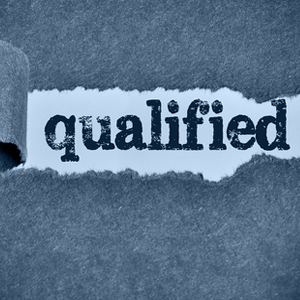Andy Paul's Blog, page 99
April 30, 2015
Bi-lateral Prospect Qualification: Buyers Are Not Qualified Until You Are
 Who’s qualifying who?
Who’s qualifying who?
Prospect qualification is a two-way street. It’s not all about you and qualifying your prospect. The prospect will also qualify you. This bilateral qualification is a key milestone in your sales process because you don’t have a truly qualified prospect until they have qualified you, too.
Qualification doesn’t just mean that the customer is a great fit for your product or service and that you’ve ticked off the usual BANT boxes. What qualification really means is that the prospect is qualified for you to invest your time in selling to them.
Think about what is at stake with qualification (or disqualification as I like to say). If you invest your limited sales time in a prospect that is not qualified to buy your product or service, then all of the sales time you spent on them will have been wasted. These wasted hours can never be recovered and it will leave you with a reduced pool of hours available to sell to other qualified prospects. In other words, sloppy prospect qualification, and disqualification, invariably lead to reduced sales productivity.
A persistent problem I see in my work with sellers is that they defer this investment decision to the prospect. They take the position that as long as the prospect is talking to them, then the prospect must be interested in what they’re selling. Therefore, they are letting the customer decide for them how they should spend their sales time.
And, this extends into the customer qualifying you. You may believe that you have a qualified prospect. You may have gone through your standard qualification process and determined that they were a qualified prospect from your perspective. But, if the prospect doesn’t believe that you are suitably qualified to be a supplier to them, then you’re at risk of wasting your sales time if you continue to pursuing them.
Just Ask
You need to ask the prospect if they’ve qualified you to be a supplier. And, by this I don’t mean that you were able to place your name on their qualified supplier list. Instead, you have to determine if they’ve reached a preliminary internal decision about which suppliers they believe can help them achieve their objectives. If they haven’t qualified you, then there’s a good chance that you’re just spinning your wheels.
To determine if the the prospect has qualified you ask the following question (Please feel free to put this into your own words!): “Do you consider us to be the supplier that is uniquely qualified to help you meet your stated objectives, pre-sales and post-sale?”
This is an intentionally loaded question that typically will generate one of three primary answers.
“No” = Not qualified.
The follow up question is “why.” And, you have to listen very closely and carefully to their answer. You’ll have a decision to make about whether to invest more of your sales time with the potential prospect. If you can determine where they believe that you have fallen short relative to their needs, or the competition, then you have to decide whether you can change their perception of your offering and be given a serious competitive chance to win their business. In most cases, the wise decision is to move on to other opportunities.
“No, but…” = Qualified but not uniquely qualified.
This means that the prospect didn’t buy your value proposition. You’re perceived to be a possible solution but the prospect doesn’t buy that you’re a better option than any of the competition. The prospect likely believes that you’re not offering enough differentiated value to change the status quo. Your follow up question in this instance will also be “why.” You need to understand whether the problem is in your value proposition or in how it was presented.
“Yes, but…” = Well qualified but with some challenges.
The good news is that prospect believes that you are positively differentiated from the competition. The challenge is that you need to be able to substantiate and validate your value proposition. The prospect’s mind could be changed if you can’t deliver the value to validate your value proposition. Your follow up is a “what” question. What additional value (in the form of data, questions, information, insights, context, case studies and so on) do they need from you in order to lock in their perception of your unique qualifications?
To complete your qualification process just ask the question. If the prospect does not consider you to be a qualified seller then persistently follow up with a “why” question(s) until you fully understand their rationale. This will give you the information you need to begin to address any perceived shortcomings in your individual sales performance, messaging or your product/service.
Effective qualification means that there is not a moment to spare for prospects who are not going to purchase from you. There is no way to know the answer to that question unless you ask.
The post Bi-lateral Prospect Qualification: Buyers Are Not Qualified Until You Are appeared first on Andy Paul | Strategies to Power Growth.

April 28, 2015
The Myth Of The Closer
Are You Selling “Things” or “Solutions”? Perhaps this is just a sign of the times, but I’m seeing more managers who attribute a shortfall in their sales numbers to a shortage of sales people who know how to ask for an order. In other words, they feel they don’t have enough “closers.”
Perhaps this is just a sign of the times, but I’m seeing more managers who attribute a shortfall in their sales numbers to a shortage of sales people who know how to ask for an order. In other words, they feel they don’t have enough “closers.”
Unfortunately, these managers are mistakenly identifying their real problem. What many managers see as a need for more “closers” is really a symptom of a broken sales process. Closers are a band-aid. They are the antithesis of selling value.
When managers feel that they have a shortage of closers what they really have is a shortage of salespeople who have the knowledge and expertise to help their prospects make value-based purchase decisions.
I love this statement from Jeff Bezos, founder and CEO of Amazon, because it concisely summarizes what selling truly is about. In an interview with the Harvard Business Review, he said “We don’t make money when we sell things. We make money when we help customers make purchase decisions.”
If you think that your primary sales challenge is that you need more “closers” then chances are that you’re just selling “things” instead of “solutions” to problems. You’re focusing on your product instead of a process that quickly provides the value that will enable the customer to make a purchase decision. As a result, the message that you’re unintentionally communicating to your customers is that you’re selling a commodity product or service instead of a solution.
Rather than hire more closers, you should focus on developing salespeople who possess a deeper understanding of the requirements of your target customers and a greater knowledge of the value provided by the products and services you are selling.
The Kind Of Closers You Really Need
When your customer appears to be having difficulty deciding, the primary thing that needs to be closed is the gap between their knowledge and understanding of their requirements and their knowledge and understanding of the value your solution will provide to meet them. If you look at this from the perspective of your buyers, then a closer should be the salesperson who possesses the knowledge, expertise and insights to close this value gap.
If you can close this gap and help your customer to better understand their requirements and the value of the solution you sell, and have demonstrated that yours is the best solution for them, then asking for the order is pretty simple. In fact, if you’ve done your job well, the asking will be a mere formality. No closer required.
In most sales situations the customer will already have made up their mind on a supplier by the time you ask for their order. Buyers whittle down the pool of prospective sellers as they go through their buying process. They may start out by evaluating five different suppliers for a particular service. But they start eliminating vendors as go through their process based on the value delivered, or lack thereof. (Buyers have little incentive to inform sellers that they no longer are in the running because they stand to benefit by encouraging the competition for their business to continue.)
If you feel that you need to rely on the mythical “closer” to win more orders then you’re admitting that your sales team falls short of helping their prospects understand the value of your product or service. Your prospects can’t make informed decisions to buy your solution because of this gap in their understanding. Instead of relying on a so-called “closer” to negotiate away your margins and diminish the value of your solution, hire and train salespeople who have the skills, knowledge, expertise and insights to help their customers make fast, favorable purchase decisions.
The post The Myth Of The Closer appeared first on Andy Paul | Strategies to Power Growth.

April 27, 2015
How Prospects Decide To Give You Their Time
 Shouting Louder Isn’t The Key to Being Heard
Shouting Louder Isn’t The Key to Being Heard
In 1971, Herbert Simon, an economist at Carnegie-Mellon University, and a future Nobel Prize winner in Economics, wrote a very accurate description of what the information revolution would look like when it occurred 25 years in the future. And he forecast the impact that the ready availability of seemingly endless quantities of information would have upon our ability to process and use it.
While Simon wasn’t specifically addressing the selling and buying of products and services, the conclusions he drew are certainly applicable in today’s sales environment.
In a paper published in 1971 Simon wrote:”..in an information-rich world, the wealth of information means a dearth of something else: a scarcity of whatever it is that information consumes. What information consumes is rather obvious: it consumes the attention of its recipients. Hence a wealth of information creates a poverty of attention and a need to allocate that attention efficiently among the overabundance of information sources that might consume it.
What Simon was describing was a situation based on the laws of economics. Namely, that the supply of any commodity, in this case the attention span of any consumer of information, is limited and that market forces will efficiently allocate that scarce resource among the various interests competing for it.
Let’s apply Simon’s lesson to the selling environment. Your prospects and customers, by definition, are consumers of information. They seek information from various sources, such as the Internet, social media and salespeople, in order to make fully informed decisions about purchasing the right products and services for their needs.
Prospects Exchange Their Time For Value
However, as Dr. Simon pointed out, your prospects and customers have a limited supply of attention to share among the various information sources requesting a piece of it. At some point during their buying process, they have to make a conscious decision about how to allocate their limited attention bandwidth between all the demands for that attention (which includes talking to potential vendors, administrative tasks, management responsibilities, meetings of various kinds, making phone calls, returning emails, updating their Facebook status and texting with their spouse, kids and friends).
Therefore, your prospects and customers are forced to make trade-offs about how they are going to prioritize the allocation of their attention bandwidth. Those sellers that provide the greatest ROI to their prospects on the time invested in them will be given more time to sell to them. This means that salespeople that consistently maximize the value they deliver to their prospects and customers will have the inside track to the order.
In my first book, Zero-Time Selling, 10 Essential Steps to Accelerate Every Company’s Sales, I show how your prospects calculate an economic return on the time they invest in you. I call this a Return on Time Invested (ROTI.) Every sales interaction you have with a prospect is judged on whether it delivers value or not. If you are careless in how you spend the precious minutes of attention the prospect has allocated to you, then they will make the perfectly rational decision to invest their time with another seller.
Sell with Maximum Impact
How can you effectively cut through the endless barrage of information confronting your prospects to grab their attention? The key is to Sell with Maximum Impact in the Least Time. Selling with Maximum Impact means to take the steps that enable you to quickly deliver the value your prospects need to make an informed purchase decision with the least investment of their attention (time).
Selling with Maximum Impact in the Least Time requires deliberate planning on the part of the salesperson. Every interaction with a prospect has to be planned to deliver the maximum value to them. Whether it is a phone call, email, text, video chat or sales call, planning for each prospect interaction has to answer the question: what value (value being defined as any information, data, questions, context or insights) does the prospect need from me today in order to move at least one step closer to making a decision?
Sell with Maximum Impact every time you interact with a prospect and you will be rewarded with all the time you need to make your case. If you can help your prospects to move through their buying process more quickly, then they will allocate more of their limited attention to you because you will have trained them to expect more value and a better return on their investment of time than your competitors.
Keep in mind that the ROTI is a two-way street. Maximize your prospects return on the time they invest with you and you will earn the maximum return, in the form of orders, on the time you invest in them.
The post How Prospects Decide To Give You Their Time appeared first on Andy Paul | Strategies to Power Growth.

April 24, 2015
Video Sales Tip: Three Essential Sales Questions To Ask About Every Prospect Every Day
The most successful salespeople I know are always ruminating about deals they have in the works. They have a command of all the details of every sales opportunity they are working. Most importantly, they have a firm grasp on the very next steps they need to take to help the customer quickly move closer to making a decision.
Want to sell like the best? Click below to learn Three Essential Sales Questions you should ask everyday about each of the qualified sales opportunities in your pipeline. Thoughtfully and pragmatically answer these questions. They’ll help you develop a realistic understanding of what your next steps should be to help your prospects make a fast, favorable decision.
The post Video Sales Tip: Three Essential Sales Questions To Ask About Every Prospect Every Day appeared first on Andy Paul | Strategies to Power Growth.

April 23, 2015
How To Convert Risk Into A Winning Sales Strategy
 Every sales opportunity carries with it risks on the part of the buyer and the seller. These risks often assume one of three forms:
Every sales opportunity carries with it risks on the part of the buyer and the seller. These risks often assume one of three forms:
1. Risk that your product/service won’t perform as you promised. This includes the risk that you won’t support the product as promised after the sale.
2. Risk that the customer won’t live up to their commitments.
3. Risk that making the wrong decision could be career limiting to the decision maker.
Here is a winning sales strategy, that I call Starting Small, that effectively reduces the real and perceived risks for buyer and seller alike, accelerates customer decision-making and increases your chances of winning the order.
1: Start new business relationships with the smallest order possible.
In every transaction between new business partners there are unknowns and concerns and a desire on both sides to minimize the risks. Starting a business relationship with a small order is the best way for the buyer and seller to become familiar with each other and set the stage for a profitable long-term relationship.
Starting Small is the easiest way for sellers to build a customer’s trust and confidence in their ability to live up to their promises to deliver a product that works as advertised.
Customers will usually welcome your suggestion to reduce the size of an initial order—especially if you are a smaller company or a new player in your industry and haven’t previously done business with them. In that case, helping the customer make the lower risk decision increases your chances of winning their business.
For instance, show your prospect the value to them of doing a proof of concept with a small order. Starting small enables you to demonstrate in a low-risk manner how your solution seamlessly integrates with their existing systems and procedures and provides the value that you said that it would. This gives you a base of trust and credibility from which to expand to meet the customer’s broader requirements.
As a seller, Starting Small will enable you to get your foot in the door and give your company a chance to prove itself. At the end of the day, who cares if your initial order is small? Once you get the first one, if you do a great job delivering on your commitments then you’ll be in a prime position to win all future orders as well.
2. Starting Small will reduce your risk as the seller.
Risk in a sell/buy transaction is not one-sided. Neither are trust and confidence. A key reason to start a customer relationship with a smaller initial order is to lower your risk in a transaction. Rather than depend on the customer to live up to their end of a larger deal, make it easier for them to start small and grow incrementally.
There are tales too numerous to count about smaller companies that won a large order from their dream customer and ended up being mortally wounded by it. How many times has a seller won a big order from a big company, bought inventory and hired people to support it, and then had the customer freeze all purchases for three to six months because it experienced a temporary downturn in earnings? The seller is stuck with inventory and overhead it doesn’t need and begins to suffer under the weight of this unanticipated financial burden.
Rightsizing your initial orders also reduces your sales risk. The bigger the order you are trying to win, the higher the level within a customer organization at which you’ll have to sell. With a smaller order, fewer internal barriers to the order will exist and it will be easier to keep the decision within the purview of lower level decision makers.
3. Starting Small will tilt the competitive playing field in your favor.
In a tight competitive sales situation, reducing the size of the prize is one of the best ways to tilt the playing field in your favor.
If you are able to help your prospect understand the value of starting small it will provide you with a competitive advantage. This is especially true for small and mid-size enterprises competing against larger competitors. Typically bigger competitors need to take orders in larger bites on order to hit their numbers. When a prospect indicates that they are seriously considering reducing the size of their initial order, the big players will often take this as a sign that the prospect is backing away from their urgency to buy something. They will start to lose interest in the deal and leave a more open field for you.
I worked for several successful start-ups selling mission-critical communications systems to some of the largest communications providers in the world. My biggest sales challenge was my customers’ natural inclination to purchase our type of product from the brand name companies in the industry. Starting Small was the sales strategy I used to steal the initial order from under the noses of the big guys and it was the catalyst for building substantial, profitable relationships with my customers. I knew that if I could sell the customer on the value of starting small that I would shift the competitive advantage to my side of the table.
Starting small isn’t reducing the ultimate size of the project. It’s just reducing the risk of the initial engagement and opening the door to more business for you. Look at this from the perspective of the customer. By rightsizing the initial order, you make it easier for the customer to make a decision. That has tangible value to them. And to you.
The post How To Convert Risk Into A Winning Sales Strategy appeared first on Andy Paul | Strategies to Power Growth.

April 22, 2015
Practice Unconditional Support
The customer is not always right. But their problem is always valid. Fix it.
 In my first book, Zero-Time Selling, I described the bond of unconditional love that new parents immediately forms with their newborn infant. They love this small person and will do anything to protect and support him or her without question and without condition. This is unconditional love. You should treat your customers the same way by practicing unconditional support. They should be loved and supported without question or condition.
In my first book, Zero-Time Selling, I described the bond of unconditional love that new parents immediately forms with their newborn infant. They love this small person and will do anything to protect and support him or her without question and without condition. This is unconditional love. You should treat your customers the same way by practicing unconditional support. They should be loved and supported without question or condition.
The fact is that practicing unconditional support is easy to do. It’s mostly a matter of prioritizing doing the right thing for your customer. And it becomes a critical opportunity to build trust, loyalty and create raving fans who will happily recommend your product or service to others.
Here are a few simple rules for practicing unconditional support.
Rule #1: Customers identify more with great support than with great features.
It’s so rare, and difficult, to be able to actually speak to a live customer support person these days that customers’ appreciation of great customer service has grown. In fact, no matter how good a salesperson you are, what happens after the sale is more influential in determining the probability of getting repeat business from a customer than anything you can do.
If your customers’ experience with your company during the post-sale phase is substantially different than it was during the pre-sales phase, then you, and your company, have a problem.
Rule #2: The customer always has a valid problem.
Much as horses sense fear in people, customers innately sense resentment and reluctance in customer-support people. Your company must treat customers and their problem with respect. Their calls are a not a bother. They did you the favor of buying your product. If you take care of them cheerfully and professionally, you will get even more orders.
What if the customer is “wrong”? The customer doesn’t care about right or wrong. All they know is that they can’t use your product or service. If you let that condition stand for any number of hours, let alone days, because you are waiting for them to acknowledge that they were at fault, then you’re not going to get another order from this account.
Rule #3: Do whatever it takes to fix their problem in the shortest time possible.
Don’t burden the customer with your baggage when trying to fix their problem. If a customer calls and says the unit you sold them has failed and they have an important customer meeting the next day and need your product to be working. What do you do? Fix the problem. Send them a loaner immediately. Don’t get hung up in your internal processes, approvals and procedures. Make it right for the customer.
Rule #4: Put your best people on support.
Your customer-support people have to be problem solvers. They have to enjoy communicating with the customer. In many respects, a customer-support person must have qualifications similar to those of the salespeople you would hire to sell your product or service. They should be thoughtful, empathic, knowledgeable about your product and service, and aggressive in reaching closure on a problem.
Insightful managers know that customer support people make great salespeople and view customer support as a stepping stone to an inside sales position. In fact, a good customer-support person will often sell more product than most of your salespeople.
Rule #5: Be humble.
Sometimes a product you sell just doesn’t work the way you expect or advertise. It could be an issue with just one unit, or it could be a shortcoming in your product line. Don’t try to bluff your way through these situations. If your product doesn’t work for the customer, take it back. Send a refund check. A simple admission of fault and a little humility can be powerful coming from a seller and will go a long way toward building brand loyalty.
Rule #6: Great service starts at the top.
The commitment to practice unconditional support has to come from the CEO and senior managers. It can’t just be talk. You have to talk the talk and walk the walk. Management needs to lead by example and practice it themselves. Think about it like this: If you were a customer of your own company, how would you expect to be supported? Make certain that your customer-support processes and staff are supporting your customers with the same level of care that you’d expect if you were in their shoes.
Orders from existing customers are the least expensive orders to capture. Practice unconditional support to build your customer base and ensure that you receive even more repeat business.
The post Practice Unconditional Support appeared first on Andy Paul | Strategies to Power Growth.

April 21, 2015
Proactive Steps To Improve The Accuracy Of Your Sales Forecast
 Do you measure salespeople and sales managers on the accuracy of their sales forecasts?
Do you measure salespeople and sales managers on the accuracy of their sales forecasts?
Developing an accurate sales forecast is a valuable skill. And, like most every other skill, the ability to create a more accurate sales forecast is one that can be improved.
Educate Your Sales Team About Why a Good Sales Forecast Matters
Don’t assume that everyone on your sales team has the business background to understand why accurate sales forecasts are so important to your company. Educate your sales team about the adverse impacts on their ability to sell that stem from poor forecasting.
For instance, if you’re a small to mid-sized manufacturer that struggles with accurate sales forecasting you might need to maintain an extra quantity of finished product in inventory in order to ensure that you can meet your promised delivery times. You’d need to educate your sales team about what that means to the company in terms of extra costs. Teach them about the trade-offs that necessarily happen when you have to tie up cash in inventory versus spending it on activities that support sales, such as lead generation, sales support, customer service or investing in adding needed features to your product line. Such can be the impacts of poor forecasting.
Be proactive and invest 15-20 minutes once per month during a sales meeting to teach your sales team about the bigger picture. Use actual data to show how overly conservative or overly aggressive forecasts can have an negative impact on their ability to sell and service their customers.
Measure The Accuracy of Your Sales Forecasts
The first step towards improving the quality of your forecasting is to measure the accuracy of the forecasts you receive from your team. As the old saying goes you can’t improve, what you don’t measure.
The quickest way to start measuring is to build a simple spreadsheet and track the accuracy of your team’s forecasts on a regular basis. Chart trends by individual sales rep. It’s important to know if the sales forecasts your team submits are consistently are high or low. And, similarly, whether they were accurate relative to dollars but wrong regarding the mix of products or services.
Provide feedback to your sales team about the accuracy of their forecast after each forecast cycle.
If your team missed their forecast, then provide them with detailed feedback about where they missed. Identify trends that indicate the specific areas where salespeople and managers may need coaching (i.e, qualification, value selling, closing). This feedback loop is critical to any effort to increase the accuracy and the value of your forecast to your company.
Coach Your Sales People to Create Consistently Better Forecasts
A good first step is to reduce your forecast cycles to a shorter period of time. The shorter the forecast period the greater its accuracy should be. A week is a good length of time as it keeps salespeople focused on what needs to happen in real time in order to close a deal.
Create a weekly Hot List that is a forecast of the deals that your sales team is absolutely positive are going to close in the current week. Review the new Hot List at the start of each week in your Monday morning sales meeting. Every sales rep must know the following information about each opportunity they placed on the Hot List:
-Why is the decision going to be made this week?
-Why are we going to win the deal?
-What additional information does the customer need from us now to make their decision?
-What resources does the salesperson need from management to help close the deal?
If a salesperson doesn’t know the answer to even one of these questions, then that opportunity needs to be removed from the Hot List and re-instated when they do.
Review the accuracy of their previous sales forecast with each sales rep.
Go through it line by line to help the sales rep understand why a particular opportunity didn’t happen as they had forecast. Develop strategies for what they could do the next time they encounter a similar situation.
Lastly, exercise caution in building your forecasts using a weighted probability-based forecasting method (that is the default for many managers and in so many CRM systems.) Assigning a probability of success based on the achievement of a certain sales milestone (i.e., submitting a proposal) is problematic at best. Let’s say that you’ve configured your CRM system to assign a 75% probability of winning to every opportunity to which you’ve submitted a proposal. If you have 3 competitors on a particular deal, who have each submitted a proposal to the prospect, then it’s impossible for all four of you to have a 75% probability of winning the sale. 25%, maybe. 75%, no.
The post Proactive Steps To Improve The Accuracy Of Your Sales Forecast appeared first on Andy Paul | Strategies to Power Growth.

April 20, 2015
There’s Sales Opportunity in Ambiguity; If You Pay Attention
 I attended a fascinating lecture in which the presenter talked about ambiguity. He espoused the view that one of the key skills that workers must develop in order to succeed in business, and in life, is a tolerance for ambiguity. Success in a rapidly changing world demands a person who is comfortable with uncertainty. When the rules for careers and the definitions of success are in a near constant state of flux, the person who is alive to the opportunities and possibilities inherent in change, is going to be better positioned to thrive.
I attended a fascinating lecture in which the presenter talked about ambiguity. He espoused the view that one of the key skills that workers must develop in order to succeed in business, and in life, is a tolerance for ambiguity. Success in a rapidly changing world demands a person who is comfortable with uncertainty. When the rules for careers and the definitions of success are in a near constant state of flux, the person who is alive to the opportunities and possibilities inherent in change, is going to be better positioned to thrive.
This tolerance for ambiguity (which some label TofA) is especially relevant for sales professionals to embrace.
Ambiguity Affects How You Prospect
For instance, take how you prospect for new customers. You might have an ideal customer profile that you are prospecting to develop. This profile probably has been developed by Marketing, with input from Sales, and encompasses a tightly defined set of criteria that your new prospects ideally should meet. Sales is given directions to prospect only for prospects that fit this profile.
That’s all good in theory. But the chances that you will find potential prospects that fit your target profile from your first sales interaction with them are pretty slim. Oh sure, you might occasionally come across a sales lead that has fully thought through their requirements and have defined a specification for what they want to buy that exactly aligns with your ideal target profile. But that won’t be the case in most situations.
The fact is that you want prospects whose exact requirements are a bit ambiguous. If they are still unclear about the specific direction they want to take, then this provides an opportunity for you to work with them to ask the right questions, deliver the right value to help them make the trade-offs between potential solutions and create a clear buying vision for the decision they have to make.
Use Ambiguity To Determine Where To Invest Your Time
I see many sales managers who coach their salespeople to screen out potential prospects that don’t fit the BANT model and are still unclear about their requirements. Here’s the problem with that sales approach: if prospects already have their requirements specified in detail before you first talk with them, then it is very likely that one of your competitors has already helped the prospect define their requirements to fit the product or service that they are selling. In other words, you’re already behind. So, which type of potential prospect should you invest your time in?
The fact is that the normal sales environment is rife with ambiguity. Good prospects don’t usually fit your exact profile and are uncertain about what they really need. And your prospects don’t buy in a way that aligns with your sales process, making it hard to accurately forecast. This creates a problem for many sellers. They want a process that is bulletproof.
Welcome the ambiguity. Don’t fear it. Use it to you’re advantage as a competitive weapon.
Ambiguity forces you to listen. If you knew with 100% certainty that a prospect would respond in particular fashion to every question you ask then you could just operate on sales autopilot. But they don’t.
A prospect may be uncertain about their requirements. They may really not know what they want. That’s not a signal to throw them back in the nurture pool and get back to them later once they decide. It’s a cue to engage in a sales serious conversation about their requirements (not your solution.)
There’s opportunity in that ambiguity. If you’re paying attention and listening, then you’ll know when the customer is asking for your assistance to help them better understand the problem they are trying to solve and to them assist in defining a better solution.
Are you alive to the opportunities that can be found in the ambiguities?
The post There’s Sales Opportunity in Ambiguity; If You Pay Attention appeared first on Andy Paul | Strategies to Power Growth.

April 17, 2015
Sales Tip Video: 4 Ways To Make A Strong First Impression
Here’s a short video with four quick recommendations for sales actions that you can take to shape your prospects’ first impressions of you and your company. First impressions, and the important customer perceptions that flow from them, are extremely powerful and sticky. Once a customer has formed their perception of you, and your company, it is extremely difficult to change. Therefore, it is extremely important to be at the top of your game from the very first opportunity you have to interact with a prospect.
The post Sales Tip Video: 4 Ways To Make A Strong First Impression appeared first on Andy Paul | Strategies to Power Growth.

April 16, 2015
Is Effective Sales Lead Follow Up an Art or an Attitude?
 Not long ago I read a blog posting about the art of the follow-up. I liked the general concept presented by the author, which was that there are skills we all can learn that will improve the effectiveness of our sales lead follow up. It was hard to argue with his premise.
Not long ago I read a blog posting about the art of the follow-up. I liked the general concept presented by the author, which was that there are skills we all can learn that will improve the effectiveness of our sales lead follow up. It was hard to argue with his premise.
However, I believe that author was putting the cart before the horse. While there are skills to be learned that, if regularly practiced, will improve the quality of your follow-up, there is one big caveat that trips up many, if not most, sellers. That catch is that before you can practice the art of the follow-up, you actually have to pick up the phone and call the prospect.
Too Many Sales Leads Are Never Followed Up
At an AA-ISP conference last fall, Ken Krogue, President of insidesales.com, reported that his company’s most recent research found that 73% of sales leads are never followed up. I’ve read other studies that show a lower, but still substantial, percentage of leads not being followed up. However, no matter which end of the statistical spectrum you subscribe to, the bottom line is that sales lead follow up suffers more from inattention than from being ineffective.
Just to be clear, a lead is not someone who merely fills out a form on your website and downloads a single piece of content. A lead is someone who asks to be contacted by you. They give their permission for Sales to reach out to them by submitting a Contact Me form on your website, or by sending an email to your sales department or by calling in to your company and asking to speak to someone in Sales. Or perhaps you’re using a lead scoring system to signal when a lead that you’ve been nurturing is ready to engage with Sales. In any event, the common denominator is that the potential prospect has invested their time in investigating your product or service. And they have reached a point in their buying process where they need to engage with Sales in order to gather the additional information they require to move their evaluation to a decision.
Prioritize Action Over Technique
When 73% of the potential prospects that proactively contact a seller don’t receive a response the central problem is not one of technique, but of attitude. Effective follow-up starts with the attitude that every lead needs to be followed up. A seller simply has to commit to take action. Quickly. Don’t worry initially about perfecting your technique. Put aside thoughts of technique until you take an action that would benefit from it.
In addition to committing yourself to follow up, you must also put in place a process that enables fast follow up. Research on sales lead follow up, such as the original insidesales.com/MIT Lead Response Management Study, unequivocally demonstrates that it is not enough to simply follow-up. The effectiveness of follow-up is also tied to responsiveness and how quickly follow-up occurs. One key finding of the MIT study is stunningly self-evident but its lessons continue to be blithely ignored by the vast majority of sellers. The study found that the faster a seller follows up with a lead the more likely they are to actually connect with the prospect. In short, any focus a prospect has placed in talking to you quickly begins to diminish once they have reached out to you.
Practice Equivalence In Your Follow Up
Use the word “equivalence” when you plan how your sales team should follow up leads. Ask yourself this question: if you were a potential prospect for the product or service that your company sells, and you submitted a sales inquiry, how would you expect your lead to be followed-up? Would you expect immediate follow-up? Would you be satisfied if there were less than a 25% chance that you’d even receive a follow up call? At a minimum, your sales lead follow-up process should provide a level of service that is equivalent to your own expectation for how a seller should follow up with you.
A while back I searching for pricing information on a particular SaaS application that I wanted to use for my business. The vendor offered up only two service options on their website: Professional (Individual) and Enterprise. Frustratingly, the company’s website contained no pricing information on either option and no way to purchase the product. I filled in a web form asking for pricing information. It took two weeks to get a response from the seller. Even at that what I got was an email response from a sales manager stating that if I wanted price information I first had to schedule a phone call with her to go over my requirements. Two weeks and all I got was a lousy email. In the meantime, I had purchased an alternative solution.
In sales, as in architecture, form follows function. The art of follow -up is less important than the act of follow-up. Commit yourself to just being in the game first and then work on mastering your craft.
The post Is Effective Sales Lead Follow Up an Art or an Attitude? appeared first on Andy Paul | Strategies to Power Growth.

Andy Paul's Blog
- Andy Paul's profile
- 4 followers





